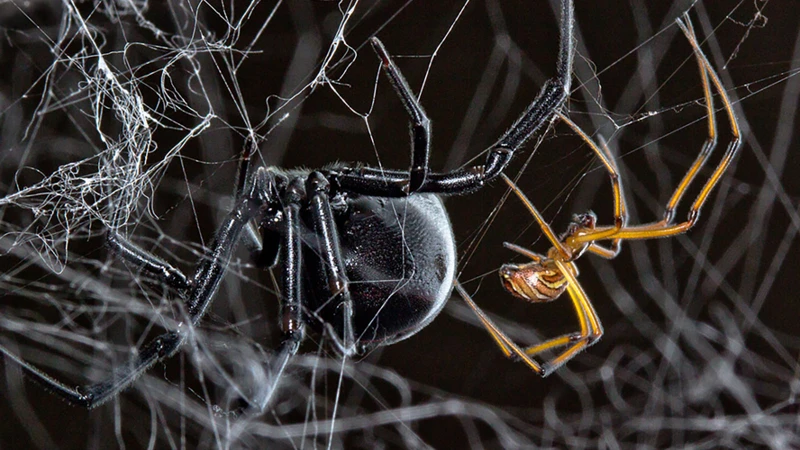Introduction
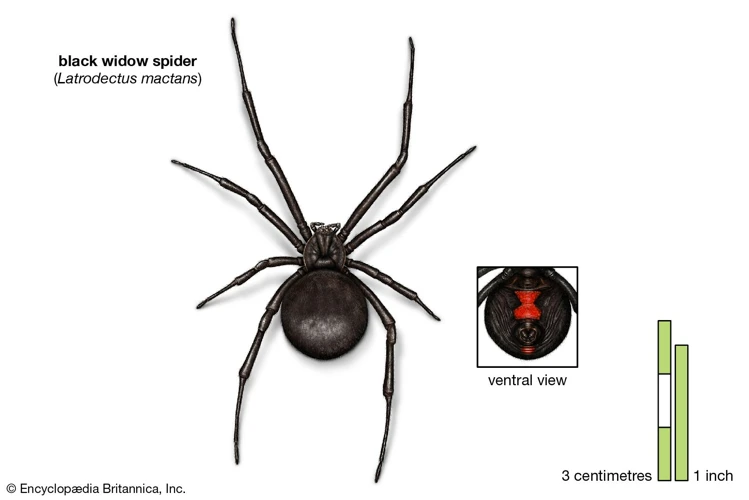
The world of arachnids is filled with complex and fascinating behavior, particularly when it comes to mating. One particular species, the black widow spider, has caught the attention of researchers due to their unique reproductive habits. In order to understand their mating behavior, it is important to examine the role of pheromones. Pheromones are a crucial component in how spiders communicate during mating, and they play a significant role in the way black widow spiders find each other and engage in reproductive behavior. In this article, we will explore the fascinating world of black widow spider mating behavior and the crucial role that pheromones play in their reproductive success.
What are Pheromones?
Pheromones are chemical signals that are secreted by an individual and received by another individual of the same species. These signals play a crucial role in communication between individuals and can affect their behavior in various ways, including reproduction and finding food sources. Pheromones can be used for many purposes, including attracting mates or marking territory. They are often species-specific, meaning that only individuals of the same species can detect and respond to these signals.
In the animal kingdom, pheromones are used extensively. They are produced by a wide range of animals, from insects to mammals. For example, in insect colonies, pheromones are used to mark trails, attract mates, and signal danger to other members of the group. In mammals, pheromones play a role in sexual attraction, territory marking, and communication between mothers and offspring.
Interestingly, pheromones are typically not consciously perceived by the animal receiving them. Instead, they are detected by specialized sensory receptors, which then trigger specific behavioral responses. These responses can include changes in reproductive behavior, foraging behavior, or social behavior.
Understanding the role of pheromones in animal behavior has been the focus of numerous studies, including research on the mating behavior of black widow spiders. To learn more about the importance of pheromones in black widow spider mating behavior, read on.
Why are Pheromones Important for Spiders?
Pheromones are crucial for spiders because they play a vital role in their communication, especially during mating. Spiders use pheromones to locate potential mates, identify individuals from their species, and even detect prey. Using pheromones allows spiders to avoid having to waste energy and resources by randomly searching for mates.
The importance of pheromones for spiders can be summarized in the following points:
- Locating potential mates: In a densely populated environment, pheromones allow spiders to locate individuals of the opposite sex that are ready to mate. This is particularly important for species, such as black widow spiders, that live in areas with many potential mates.
- Species identification: Pheromones also play a role in allowing spiders to identify individuals of the same species. This helps to reduce instances of mistaken mating attempts which can be costly in terms of energy and reproductive success.
- Resource allocation: For male spiders, the use of pheromones helps to determine whether a potential mate is worth pursuing or not. Males can assess the quality of a potential mate by the pheromones released by females. This ensures that males do not waste precious resources pursuing poor quality mates.
- Mating success: Pheromones also play a significant role in a spider’s success during mating. Male spiders that use pheromones are more likely to locate receptive females. This is essential, as the mating process in spiders can be dangerous for males.
Pheromones are critical for black widow spider mating behavior. Without pheromones, black widows would have a much harder time finding a mate, locating prey, and avoiding dangerous situations.
Black Widow Spider Mating Behavior
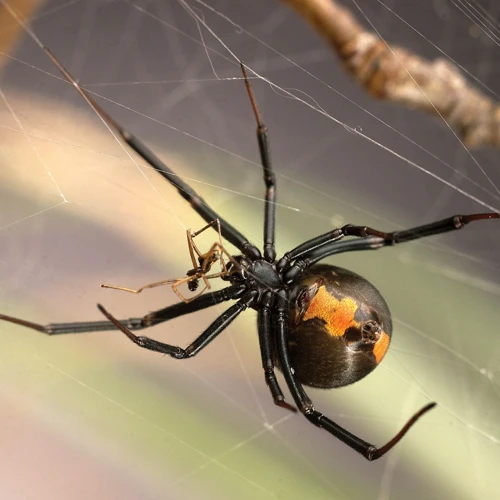
The mating behavior of the Black Widow Spider is a fascinating and complex process. Understanding how male and female spiders find each other and the role of pheromones in their communication is essential to better understanding this species. This article will delve into the different aspects of Black Widow Spider mating behavior, including how males find females, the importance of pheromones in their mating process, and research on Black Widow Spider pheromones. Additionally, we will highlight some of the most interesting and surprising discoveries scientists have made about this species.
How do Male Black Widow Spiders Find Females?
Male black widow spiders locate females through a combination of sensory cues, including visual and chemical signals. These spiders have several pairs of eyes, which allow them to detect movement and light. However, their primary method of finding a mate is through the detection of female pheromones. Female black widow spiders release sex pheromones to indicate their readiness to mate.
To locate a female, male black widow spiders follow a trail of pheromones that the female leaves behind. This trail is made up of chemicals that the female deposits on the ground as she moves through her environment. The male spider picks up on these chemicals using sensory receptors on his legs and pedipalps, which are modified appendages used for reproduction.
Interestingly, male black widow spiders are able to distinguish between the pheromones of females that are ready to mate and those that are not. Male black widow spiders can detect the level of pheromones released by a female, which allows them to assess her reproductive status. This ability is important because, as we will explore further in this article, mating with a female too early or too late can have serious implications for the male’s fitness and survival.
The use of pheromones in mate location is a common tactic among many spider species and is an important element of black widow spider biology.
The Importance of Pheromones in Black Widow Spider Mating
The importance of pheromones in the mating behavior of black widow spiders cannot be overstated. Male black widow spiders rely heavily on sex pheromones produced by females to locate and court potential mates. These pheromones are specific to the species, and allow males to identify and locate females even in the dark or when other sensory cues are not available.
In addition to attracting males, these pheromones also play a critical role in female mate choice. Female black widows can determine the quality of potential mates based on the pheromone signals they receive. This allows females to select mates who are genetically compatible and who may provide the best resources for her offspring.
The use of pheromones in black widow spider mating is not without its risks, however. Males who have located a female’s web and are in the process of mating are at risk of being cannibalized by the female. This risk may be increased in situations where resources are scarce, and females are more likely to prioritize their own survival over that of their mates.
Despite these risks, the importance of pheromones in black widow spider mating cannot be ignored. Research into the specific pheromones produced by black widow spiders and how they function in the mating process can provide valuable insights into the evolution of sexual communication and mate choice in spiders and other organisms.
For more information on black widow spider mating behavior, please visit our article on black widow spider mating behavior.
Types of Pheromones
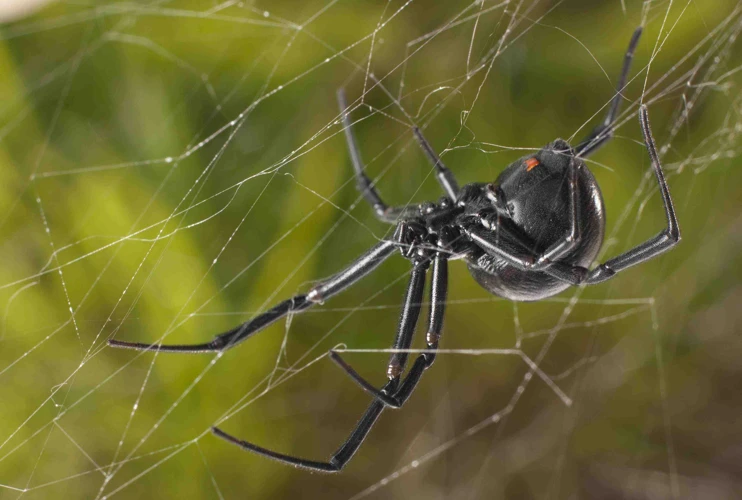
It’s fascinating to learn about the different types of pheromones secreted by spiders. These chemical messengers are responsible for a wide range of behaviors, from aggregation to courtship to territory marking. In this section of the article, we’ll explore the various types of pheromones found in the black widow spider. Understanding the nuances of black widow pheromones can provide valuable insights into the complex mating behavior of these spiders.
Aggregation Pheromones
Aggregation pheromones are chemicals that are used by spiders to attract other spiders of the same species to a specific location. These pheromones are commonly used by spiders during the winter months when they group together for warmth and to mate. Scientists have found that the aggregation pheromones found in the webs of black widow spiders are particularly potent.
One study found that male black widow spiders are attracted to webs that contain aggregation pheromones produced by other males, possibly because they are signaling that the location is a good one for finding females. This behavior seems to be a social one, as males are more likely to approach webs that contain other males than those that are empty.
Interestingly, female black widow spiders may also use aggregation pheromones to attract other females to a specific web. This behavior may be related to the competition for resources and mates that occurs among female black widow spiders.
The use of aggregation pheromones in black widow spider behavior is just one example of how these chemicals play an important role in spider social behavior. They help attract individuals to specific locations and facilitate communication between individuals of the same species. To learn more about black widow spider behavior, check out our article on black widow courtship.
Sex Pheromones
Sex Pheromones are chemical substances produced by female spiders to attract male spiders for mating. These pheromones are species-specific and are detected by male spiders through their chemosensory organs, located on their legs or palps. Once a male detects the pheromones, he follows the scent trail to locate the female.
Studies have shown that female black widow spiders produce a specific sex pheromone that is attractive to male black widow spiders. The pheromone is composed of several different chemicals, including 3-carene, which is found in the cuticle of female spiders. This chemical plays a crucial role in attracting male spiders and facilitating mating.
One interesting aspect of black widow spider mating behavior is that male spiders may use other cues to locate females in addition to pheromones. For example, the availability of resources, such as prey or shelter, may impact the distribution of females in an area and influence male mating behavior. Additionally, genetics may play a role in female mate choice, as studies have shown that females are more likely to mate with males that are genetically dissimilar to themselves.
Researchers have also investigated the costs and benefits of black widow spider mating, as it is often associated with sexual conflict and cannibalism. While male spiders face a risk of being eaten by females during mating, the benefits of successfully fertilizing eggs may offset this risk. Males may use ornaments to attract females and increase their chances of successfully mating.
Sex pheromones are important for black widow spider mating behavior and play a critical role in attracting male spiders to females. However, other factors such as resource availability and genetics may also impact mating behavior. Understanding the complexities of spider mating behavior is an ongoing area of research that has implications for animal behavior and evolution. For more information on male-female dynamics in black widow spider mating, check out our article on male prey defense and female mate choice.
How Pheromones Work
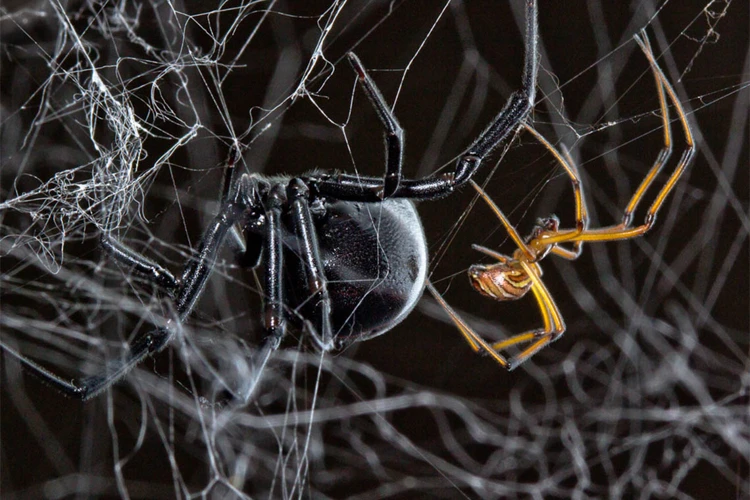
Have you ever wondered how pheromones work? These chemical messengers play a crucial role in the communication and behavior of black widow spiders. From attracting mates to signaling danger, pheromones are essential for the survival of these venomous arachnids. In this section, we will delve deeper into the workings of pheromones and how they contribute to the mating behavior of black widow spiders. But first, let’s review some of the key findings on black widow spider mating behavior and the role of pheromones that we explored in earlier sections. For more information on these topics, you can check out our articles on resource availability and mating, mate choice and genetics, sexual conflict, costs and benefits, sexual conflict and cooperation, cannibalism, and mate choice and ornaments. Now, let’s dive into the fascinating world of pheromones.
The Pheromone Communication Process
The pheromone communication process is an intricate system that black widow spiders use to locate potential mates. This system can be broken down into several distinct steps, as outlined below:
| Step | Description |
|---|---|
| Pheromone production | Male black widow spiders produce pheromones in specialized glands located on their legs or abdomen. These pheromones are released into the air and are detected by female spiders. |
| Pheromone detection | Female black widow spiders have specialized sensory receptors, known as chemoreceptors, which are capable of detecting pheromones. These receptors are located on the spider’s abdomen and are tuned specifically to pick up on the pheromones produced by males of the same species. |
| Orienting to the pheromone source | Once a female detects a male’s pheromones, she will orient herself towards the source and begin to move closer to the male spider. This can involve crawling along the ground or climbing up vertical surfaces, depending on where the male is located. |
| Mating | Once the male and female spiders have located each other, they will engage in a complex courtship ritual that involves the exchange of additional pheromones, tactile communication, and potentially violent behavior. If all goes well, the male will successfully mate with the female and will usually die soon afterwards. |
As you can see, the pheromone communication process is a critical part of black widow spider mating behavior. Without the ability to produce and detect pheromones, these spiders would likely struggle to find each other in the wild and would have difficulty reproducing. Understanding how this system works is important for researchers who are interested in black widow spider behavior, as well as for individuals who live in areas where these spiders are common. By learning more about the pheromone communication process, we can gain a greater appreciation for the complex and often misunderstood world of spider behavior.
The Role of Sensory Receptors
Spider sensory receptors are responsible for detecting pheromones and transmitting the information to the spider’s brain. These receptors are found on the spider’s legs and usually take the form of tiny hairs, called trichobothria. There are two major types of sensory receptors in spiders: chemoreceptors and mechanoreceptors.
Chemoreceptors: These receptors detect chemicals such as pheromones in the environment. Chemoreceptors are responsible for the spider’s sense of smell but they are also involved in taste and touch. They can detect even the smallest levels of pheromones, meaning that spiders have an incredibly sensitive sense of smell.
Mechanoreceptors: These receptors detect mechanical signals like vibrations and changes in pressure in the environment. They are responsible for detecting the movements of objects around the spider and for detecting prey. Unlike chemoreceptors, mechanoreceptors are not involved in detecting pheromones.
When a male black widow spider detects pheromones released by a female spider, his chemoreceptors on his legs and pedipalps (a pair of appendages near the spider’s mouth) are activated. These chemoreceptors detect the volatile pheromones and send signals to the spider’s brain, which processes the information and triggers a behavioral response in the male spider.
There are many different types of chemoreceptors in spiders, each specialized for detecting specific types of pheromones. For example, some chemoreceptors are only sensitive to sex pheromones, while others are sensitive to both sex and aggregation pheromones.
Sensory receptors play a crucial role in the pheromone communication process, allowing male black widow spiders to detect the pheromones released by females and respond accordingly. These receptors are incredibly sensitive and can detect even the smallest levels of pheromones, making them an essential component of black widow spider mating behavior.
Research on Black Widow Spider Pheromones
As scientists have become increasingly interested in understanding the complex mating behaviors of black widow spiders, research has turned to the role of pheromones. The use of these chemical signals has been found to play a crucial part in the spiders’ mating rituals. Through the use of advanced technologies and experimental methods, researchers have shed new light on the workings of these pheromones and their effects on black widow spider behavior. Let’s take a closer look at what they have found.
What Scientists Have Discovered About Black Widow Spider Pheromones
Over the years, scientists have conducted various experiments to uncover the secrets of black widow spider pheromones. Through their research, they have discovered the following:
1. Black widow spiders produce multiple pheromones: Female black widow spiders are said to produce multiple pheromones to attract their male counterparts. These pheromones differ in their chemical composition and are released through different glands in the female’s body.
2. Male black widow spiders are attracted to specific pheromones: Male black widow spiders are attracted to specific pheromones produced by female spiders. The pheromones released by the female black widow spiders have a unique chemical signature that triggers a response in male spiders, leading them towards the source of the pheromones.
3. Pheromones play a crucial role in mating: Pheromones are a vital means of communication during the black widow spider mating process. The male spiders can detect the pheromones released by females from a distance and follow the scent trail to locate females for mating.
4. Pheromones can act as a deterrent: Apart from attracting males, pheromones can also serve as a deterrent to protect female black widow spiders from unwanted attention. Some studies suggest that females can alter the chemical composition of their pheromones to discourage male spiders from approaching them.
5. Pheromones can be used for pest management: The discovery of pheromones and their role in black widow spider communication has opened up new avenues for pest management. By identifying and synthesizing these pheromones, it is possible to develop new pest control techniques that target specific spider species without harming other organisms.
The research on black widow spider pheromones has provided valuable insights into spider behavior and opened up new avenues for research in the field of pest control. By understanding the role of pheromones in spider communication, scientists can develop more effective methods for managing spider populations.
Implications of Research Findings
After studying the Pheromone communication process and the role of these special chemical compounds in Black Widow Spider mating behavior, scientists have made some fascinating discoveries that could have broader implications beyond the world of spiders.
One of the most significant findings is that pheromones could be used to develop new pest management strategies. Because spiders use pheromones to attract mates and locate prey, scientists are exploring the possibility of developing pheromone-based traps that could help control spider populations in areas where they pose a significant threat to public health.
Additionally, the study of spider pheromones can help us better understand the evolution of mating behavior and sexual selection. The fact that male black widow spiders risk their lives to mate with females suggests that the reproductive success of males is an essential factor in the survival of the species.
The research also raises questions about the chemical signals that humans may be emitting without even realizing it. While we don’t use pheromones in the same way that spiders do, studies have shown that we release chemical compounds that can influence the behavior of those around us. This raises the possibility that we may be unconsciously communicating with each other on a chemical level.
The research into Black Widow Spider pheromones has far-reaching implications for understanding the mechanisms of sexual attraction and communication, as well as potential applications in pest management. It also reminds us that there is still so much we have yet to discover about the natural world and the chemical signals that govern our behaviors.
Conclusion
In conclusion, the role of pheromones in black widow spider mating behavior is a fascinating topic that continues to captivate researchers and scientists alike. Through extensive research, scientists have gained insights into the various types of pheromones that black widow spiders use, as well as how these pheromones work to facilitate mating behaviors.
Overall, it is clear that pheromones play a critical role in the ability of male black widow spiders to locate and mate with females. Without pheromones, the chances of successful mating decrease significantly. These findings have important implications not just for the study of spiders, but also for our understanding of the wider world of animal behavior and communication.
Moving forward, it will be interesting to see the continued research and discovery in this area. As our understanding of pheromones and their effects on mating behavior deepens, we will no doubt gain new insights and develop a greater appreciation for the complex and intricate workings of the natural world.
Frequently Asked Questions
What is the purpose of pheromones?
Pheromones are chemical signals that organisms use to communicate with each other within their species.
What are the different types of pheromones?
There are two main types of pheromones: aggregation pheromones and sex pheromones.
How do male black widow spiders find females?
Male black widow spiders use their sense of smell to detect the pheromones released by females.
How important are pheromones in black widow spider mating behavior?
Pheromones play a crucial role in black widow spider mating behavior as they allow males to locate females and females to signal their readiness to mate.
What is the pheromone communication process?
The pheromone communication process involves the release of chemical signals by one organism which are then detected by another organism using sensory receptors.
What role do sensory receptors play in pheromone communication?
Sensory receptors are responsible for detecting pheromones and triggering a response in the organism receiving the signal.
What have scientists discovered about black widow spider pheromones?
Research has shown that male black widow spiders can detect the pheromones released by females from up to 150 meters away and that there are differences in the pheromones released by juvenile and adult females.
What are the implications of research findings on black widow spider pheromones?
Further research on black widow spider pheromones could lead to the development of new pest control methods that target specific pheromones to disrupt mating behavior.
How do pheromones work?
Pheromones work by triggering a behavioral response in the organism receiving the signal. This can include mating behavior, territorial marking, and aggregation.
Can pheromone-based pest control methods be harmful to non-target species?
While pheromone-based pest control methods are generally considered safe for non-target species, there is always the potential for unintended consequences and careful consideration should be given before implementing any new pest control strategy.

